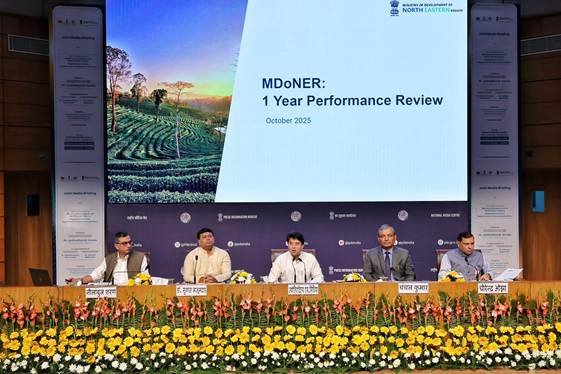BESS being integrated at both grid and project levels
Global investors are not exiting India’s renewable energy sector but they are repositioning towards integrated and storage-backed portfolios, said the Ministry of New and Renewables Energy on 22 Oct.
“The sector’s fundamentals — strong demand growth, policy continuity, and cost competitiveness — remain firmly intact,” it underlined in an industry update.
“Despite short-term delays, India remains a magnet for clean energy capital. Renewable tariffs continue to be among the lowest globally, ensuring long-term competitiveness,” the Ministry underlined http://commerce.gov.in.
Over 40 GW of awarded renewable projects are presently in advanced stages of securing PPAs, PSAs, or transmission connectivity — a clear reflection of the sector’s robust pipeline of committed investment, said the Ministry of New and Renewables Energy in an industry update on 22 Oct https://www.conexpoconagg.com/.
“The reality is that India’s renewable market has outpaced the pace of its grid and contractual institutions, a challenge common to all countries undergoing large-scale energy transitions,” it added.
In this context, enforcement of Renewable Power Purchase Obligation by states/ DISCOMs, upgrading the transmission lines for evacuation of power and use of technology for grid integration remain top priorities before going ahead with large scale bids for RE, the Ministry elaborated https://www.globaltenders.com/.
In the current year, Central Renewable Energy Implementing agencies (REIAs) have done bids for 5.6 GW, while State agencies have done bids for 3.5 GW.
Additionally Commercial and Industrial Consumers are likely to add nearly 6 GW of renewable energy capacity in calendar year 2025. Thus, capacity addition of RE is progressing through multiple pathways and not necessarily through REIA led bids alone https://ted.europa.eu/en/.
“Global headwinds have also played a role: supply-chain disruptions, fluctuating module prices, and tighter financing conditions have slowed commissioning timelines. Yet India continues to add 15–25 GW of new renewable capacity annually — a rate that remains among the fastest in the world,” said the Ministry https://www.nseindia.com/.
A Deliberate Policy Pivot
Over the past two years, policy attention has consciously shifted from pure capacity growth to system design.
Tenders for RE power with energy storage or peak power supply now dominate auctions, signaling a move toward firm and dispatchable green power https://www.bseindia.com/.
Battery Energy Storage Systems (BESS) are being integrated at both grid and project levels, marking the emergence of a new market.
Domestic manufacturing, incentivised through the Production-Linked Incentive (PLI) scheme, Domestic Content Requirement, imposition of duties, implementation of ALMM, and duty exemptions for capital equipment, is reducing import dependency and creating industrial depth.
In addition, the recalibration of GST structures and ALMM provisions represents a strategic consolidation phase, aligning fiscal policy with the twin objectives of domestic value chain depth and technology assurance https://sbi.com.in/.
Far from being disruptive, these adjustments are designed to stabilise costs, enhance module reliability, and promote scale efficiencies in India’s maturing solar manufacturing ecosystem.
Concurrently, the trajectory of battery storage deployment is advancing through viability gap–funded projects, sovereign tenders, and emerging storage obligations, establishing the foundation for firm, dispatchable renewable capacity. These measures signal a shift from expansion-led growth to a more resilient, quality-driven, and system-integrated renewable energy architecture.
Such transitions take time to yield visible capacity figures, but they represent lasting structural progress — the kind that underpins a robust energy future http://iea.org.
Transmission Reforms Poised to Unlock Over 200 GW of Renewable Potential
Transmission has emerged as the new frontier. India’s grid is being reimagined through the Rs.2.4 lakh crore Transmission Plan for 500 GW, linking renewable-rich states with demand centres.
The Government is prioritizing investment in transmission infrastructure through the Green Energy Corridors and new high-capacity transmission lines from Rajasthan, Gujarat, and Ladakh. While these projects are multi-year efforts, once operational they will unlock over 200 GW of new renewable capacity. The current stage is therefore temporary – a transition lag, not a structural ceiling https://www.opec.org/.
Government has already planned for building HVDC corridors and boosting inter-regional transmission capacity from 120 GW today to 143 GW by 2027, and 168 GW by 2032, said the Ministry.
The Real RE Story: From Expansion to Integration
The deeper story is one of evolution, not erosion. India’s clean energy transition is entering a phase where the core challenges are about integration, reliability, and scale efficiency. A temporary flattening of project pipeline in this context is a mark of maturity. The sector is doing the harder work now — synchronising renewables with grid infrastructure, financial discipline, and long-term market design.
To complement physical grid expansion, Virtual Power Purchase Agreements (VPPAs) and other market-based instruments will play a pivotal role in accelerating renewable energy deployment. VPPAs allow corporate and institutional buyers to contract renewable power virtually—decoupling procurement from physical delivery—thereby deepening demand, providing price certainty to developers, and stimulating private investment in projects awaiting grid connectivity.
Coupled with green attribute trading, market-based ancillary services, and day-ahead and real-time market integration, these instruments will create a robust ecosystem for flexible, demand-driven renewable growth. Such mechanisms are in the process of being strategically incorporated under the Electricity (Amendment) Bill or through CERC market regulations, with enabling policy support from MNRE and MoP, to align corporate procurement, grid flexibility, and national decarbonisation targets.
Looking Ahead
The next phase of growth is already taking shape:
Large hybrid and RTC projects are moving into execution across Rajasthan, Gujarat, and Karnataka;
Offshore wind and pumped hydro storage are gaining momentum;
Distributed solar and agrovoltaic initiatives under PM Suryaghar and PM KUSUM are deepening rural participation;
The National Green Hydrogen Mission is linking renewables with industrial decarbonisation;
RE integration through strengthening of Green Energy Corridor Phase III.
These are the levers that will propel India toward its 2030 targets — not by sheer speed, but by strategic endurance.
The Ministry underlined that India’s clean energy transition is not defined by quarterly numbers but by institutional durability and stickability. “After a decade of sprinting, the sector is learning to move forward by synchronising capacity with grid strength, local manufacturing, and financial stability.
“India’s RE journey is, in a phase of consolidation — one that ensures that when the next acceleration comes, it will be both faster and far more sustainable. India’s renewable story has not lost momentum. It has gained maturity.” Fiinews.com











